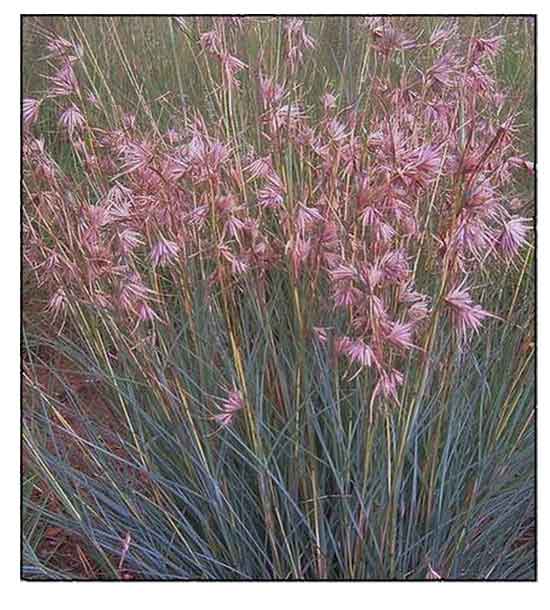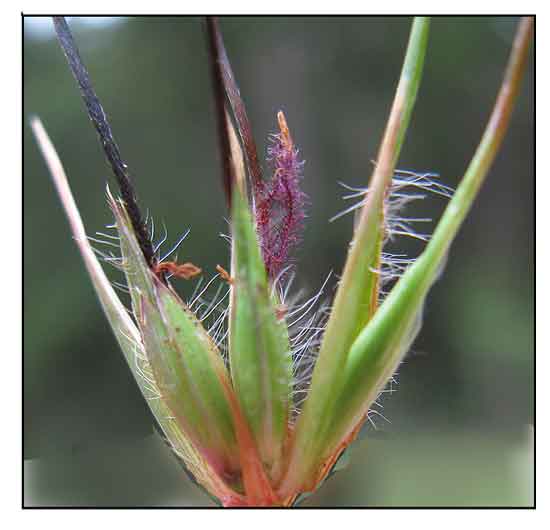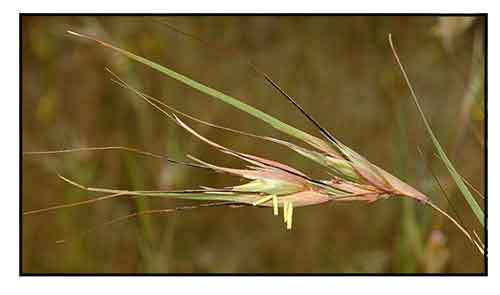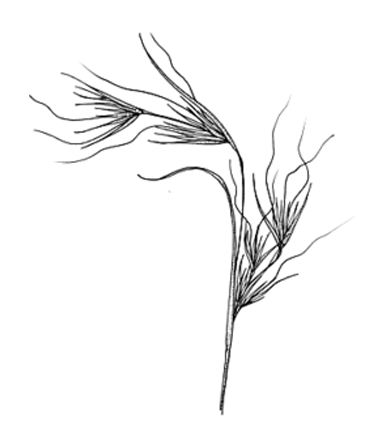
Family • Poaceae
Samsamon
Themeda triandra Forssk
RED OAT GRASS / KANGAROO GRASS
Huang bei cao
| Scientific names | Common names |
| Andropogon ciliatus Thunb. | Bagokbok (Tagalog) |
| Andropogon tenuipedicellatus Steud. | Ipatpatey (Bontok) |
| Anthistiria argentea Nees | Samsamon (Ilokano) |
| Anthistiria arguens var. japonica (Andersson) Miq. | Anglegrass (Engl.) |
| Anthistiria arguens f. japonica Andersson | Kangaroo grass (Engl.) |
| Anthistiria australis R.Br. | Red grass (Engl.) |
| Anthistiria barbata Desf. | Red oat grass (Engl.) |
| Anthistiria brachyantha Boiss. | |
| Anthistiria caespitosa Andersson | |
| Anthistiria ciliata Cav. ex Spreng. | |
| Anthistiria ciliata var. brachyantha (Boiss.) Boiss. | |
| Anthistiria ciliata var. burchellii (Hack.) Hack. | |
| Anthistiria ciliata var. mollicoma Nees | |
| Anthistiria ciliata var. syriaca (Boiss.) Boiss. | |
| Anthistiria cuspidata Andersson | |
| Anthistiria depauperata Andersson | |
| Anthistiria desfontainii Kunth | |
| Anthistiria forskalii Kunth | |
| Anthistiria glauca Desf. | |
| Anthistiria imberbis Retz. | |
| Anthistiria imberbis var. argentea (Nees) Stapf | |
| Anthistiria imberbis var. burchellii (Hack.) Stapf | |
| Anthistiria imberbis var. mollicoma (Nees) Stapf | |
| Anthistiria imberbis var. roylei Hook.f. | |
| Anthistiria imberbis var. vulgaris (Hack.) Hook.f. | |
| Anthistiria japonica Willd. | |
| Anthistiria paleacea (Poir.) Ball. | |
| Anthistiria polystachya Roxb. | |
| Anthistiria puberula Andersson | |
| Anthistiria punctata Hochst. ex A.Rich. | |
| Anthistiria subglabra Buse | |
| Anthistiria syriaca Boiss. | |
| Anthistiria vulgaris Hack. | |
| Apluda barbata Llanos | |
| Apluda imberbis Steud. | |
| Calamina imberbis (Retz.) P.Beauv. | |
| Stipa arguens Houtt. | |
| Stipa paleacea Poir. | |
| Themeda australis (R.Br.) Stapf | |
| Themeda barbata (Desf.) Veldkamp | |
| Themeda barbinodis B.S.Sun & S.Wang | |
| Themeda brachyantha (Boiss.) Trab. | |
| Themeda forskalii Hack. | |
| Themeda forskalii var. argentea (Nees) Hack | |
| Themeda forskalii var. burchellii Hack | |
| Themeda forskalii var. glauca Hack | |
| Themeda forskalii var. imberbis (Retz.) Hack. | |
| Themeda forskalii subvar. japonica (Andersson) Hack. | |
| Themeda forskalii var. major Hack | |
| Themeda forskalii var. mollissima Hack | |
| Themeda forskalii var. paleacea (Poir.) T.Durand & Schinz | |
| Themeda forskalii subvar. subglobosa Hack. | |
| Themeda forskalii var. vulgaris (Hack.) Hack | |
| Themeda glauca Trab. | |
| Themeda imberbis (Retz.) T.Cooke | |
| Themeda japonica (Andersson) Tanaka | |
| Themeda japonica var. viridiflora Hon da | |
| Themeda triandra Forssk. | |
| Themeda triandra var. brachyantha (Boiss.) Hack. | |
| Themeda triandra var. bracteosa Peter | |
| Themeda triandra var. burchellii (Hack.) | |
| Themeda triandra var. glauca (Hack.) Thell. | |
| Themeda triandra var. hispida Stapf | |
| Themeda triandra var. imberbis (Retz.) Hack. | |
| Themeda triandra subvar. japonica (Andersson) Rendle | |
| Themeda triandra subsp. japonica (Andersson) T.Koyama | |
| Themeda triandra var. japonica (Andersson) Makino | |
| Themeda triandra var. punctata (Hoxhst. ex A.Rich.) Stapf | |
| Themeda triandra var. sublaevigata Chiov. | |
| Themeda triandra var. syriaca (Boiss.) Hack. | |
| Themeda triandra var. tachysapthea Gooss. | |
| Themeda triandra var. vulgaris (Hck.) Domin | |
| Themeda unica S.L.Chen & T.D.Zhuang | |
| Themeda trianda is an accepted species. It has 73 synonyms. KEW: Plants of the World Online | |
| Other vernacular names |
| AFRICA: Rooigras. |
| CHINA: Huang bei cao. |
| INDONESIA: Merakan lanang. |
| CAMBODIA: Sbö':w. |
| LAOS: Hnaaz feek. |
| THAILAND: Ya-faek. |
| VIETNAM: Co'bong cao ru'[n]g knop; Co'tam hu[n]g. |
September 2023
![]()
 |
| PHOTOS / ILLUSTRATIONS |
| IMAGE SOURCE: Photo: Themeda triandra florets / © D & H Seed Harvest Co / Noncommercial Use / click on image or link to go to source page / DHSeedHarvestCo |
| OTHER IMAGE SOURCE: Photo: Themeda triandra with tubercle hairs/ Harry Rise / CC Attribution 2.0 Generic / click on image or link to go to source page / Wikimedia Commons |
| OTHER IMAGE SOURCE: Photo: Themeda triandra flowering plants / M Fagg / Australian National Botanic Gardens / Noncomercial use / click on image or link to go to source page / Useful Tropical Plants |
| OTHER IMAGE SOURCE: Illustration: Themeda triandra - Line drawing / PlantNET / Noncomercial use / click on image or link to go to source page / PlantNET |
Additional
Sources and Suggested Readings |
• |
DOI: It is not uncommon for links on studies/sources to change. Copying and pasting the information on the search window or using the DOI (if available) will often redirect to the new link page. (Citing and Using a (DOI) Digital Object Identifier) |
| List of Understudied Philippine Medicinal Plants |
• |
 |





